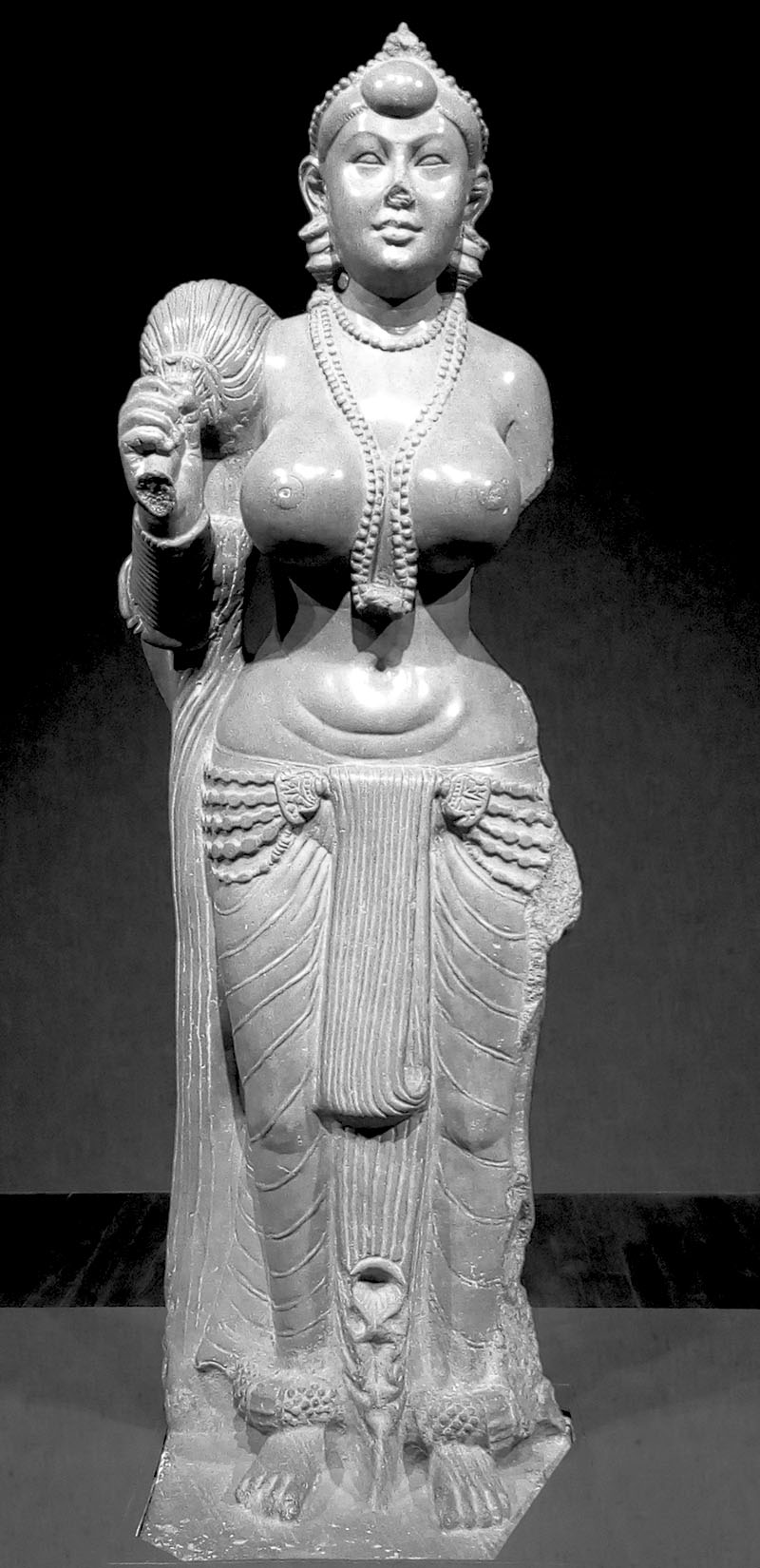A life-sized Chunar stone statue of a female deity or guardian figure, possibly a yakshi, excavated from Didarganj, near present-day Patna, the Didarganj yakshi statue is widely celebrated for its intricacy, polished surface and overall symmetry, as well as naturalistic and standardised style. The figure is depicted carrying a fly-whisk in her right hand, while her left arm and nose are damaged. The statue rests on a 40-centimetre tall stand, bringing it to a total height of 203 centimetres — all of which was carved from a single block of stone.
The Didarganj yakshi was rediscovered by accident on the banks of the Ganga by local residents in October 1917 and was worshipped for a brief period before being acquired by colonial-era archaeologists and moved to the Patna Museum. The explanation offered to the locals was that the statue represented a guardian figure, not a deity, and so was not intended for worship. This claim has been debated; the statue is widely, if not universally, considered to be a yakshi, qualifying as an elevated guardian deity meant to flank a more important figure on a temple wall or entrance. The interpretation rests on whether the fly-whisk is considered a sign of an attendant’s subservience or a guardian’s shared glory. Other features of the sculpture, namely its size, polished surface and carefully carved details such as the jewellery and drapery, have favoured the latter interpretation, indicating that the statue may have been positioned in a place of importance.
The Didarganj yakshi has also been the focus of much debate on style, valuation, colonial and postcolonial biases and the representation of women in both ancient art and written art history. The age of the statue is also disputed, with earlier scholars placing it in the third century BCE while more recent scholarship places its origins in the first century CE. As a result, the artistic tradition and imperial patronage of the statue remains uncertain. Its naturalistic and standardised style may have been overvalued by colonial-era scholarship’s emphasis on Gandharan sculpture and Ashokan capitals. And so, possibly in an attempt to create distance between the history of Indian art and the Hellenic and Achaemenid roots of these sculptural traditions, the Didarganj yakshi, along with other sculptures, were dated to the third century BCE and presented as examples of a fully Indian style that was at least as old as sculptures like the Persianate lions of the Sarnath capital.
The nationalistic fervour of the twentieth century encouraged the argument that the statue was of Mauryan origin, but without the Persian influence. This claim was further developed on the basis that the statue was made from polished stone — which is characteristic of Mauryan sculpture — and its discovery near Patna, the former capital of the Mauryan Empire. However, more recent scholarship asserts that both the polish and the naturalistic rendering of the figure was a lingering stylistic influence adopted by sculptors operating under the Central Asian Kushan Empire in the first or second century CE, about three hundred years after the Mauryans. This theory is supported by the double bundle in the yakshi’s hair, a popular style and artistic choice among sculptures of the Kushan Empire. This later date aligns with the progressive standardisation of Indian sculpture in the first millenium CE, whereas placing the yakshi in the third century BCE would create a centuries-wide gap in that history.
The statue’s prominent breasts and wide hips have also been the focus of much debate. One interpretation has been that — much like the surasundaris on the walls of the Khajuraho temples from nearly a millennium later — the yakshi’s voluptuous form was seen as the beginning of an aesthetic path to spiritual understanding, wherein eroticism is seen simply as another play of form. Another view was that the yakshi’s exaggerated and sexualised features represented fertility and young motherhood, although both these views are at odds with the guardian duties or the iconographic role of a yakshi. It is generally agreed that her appearance was originally envisioned as an idealised version of the female body, and a depiction made as a matter of course rather than a conscious act of representation.
The Didarganj yakshi was first housed in the Patna Museum and has been exhibited across the world as a fine example of Indian sculpture, including the 1947 exhibition “Art from the Dominions of India and Pakistan” in London and the “Festivals of India” exhibitions in France and the USA in the mid-1980s. Upon discovering slight damage to the yakshi’s left cheek when the statue returned to New Delhi, the Patna Museum refused to take it back without compensation to the Bihar government. The statue was finally returned to Patna in 1989 and moved to the Bihar Museum in 2017.







